
|
|||||||||||||||||
| 童謡 Douyou = Nursery rhymes / Children's song | |||||||||||||||||
| Educator Seiji Haruta | |||||||||||||||||
|
|
|||||||||||||||||
| Regarding Japanese Education At the heart of Japanese education is 教育勅語 (Kyouiku Chokugo: The Imperial Rescript on Education). When the educated people became teachers before the war, they also educated postwar children on this basis. This is the basis of Japanese morals and has a great influence on Japanese culture, music and various media. |
|||||||||||||||||
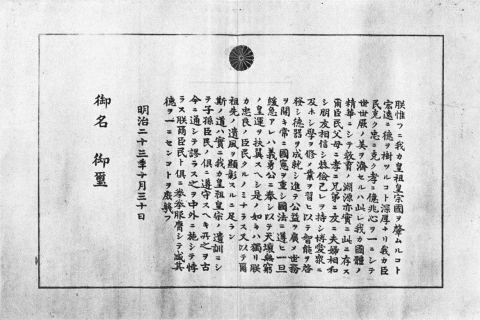 The transcript of Imperial Rescript on Education issued by the Ministry of Education to schools |
|||||||||||||||||
The Imperial Rescript on Education (教育に関する勅語, Kyouiku ni Kansuru Chokugo), or IRE for short, was signed by Emperor Meiji of Japan on 30 October 1890 to articulate government policy on the guiding principles of education on the Empire of Japan. The 315 character document was read aloud at all important school events, and students were required to study and memorize the text. The term "勅語” (Chokugo) means in general usage a formalized and publicized version of the emperor's so-called "words", which the emperor conveys as a statement of politics and administration. is there. Emperor Meiji's edict was promulgated as a basic policy of education in modern Japan. Promulgated on October 30, 1890 (Meiji 23), abolished on June 19, 1948 (Showa 23). This is the imperial rescript that was the basis of moral education in Japan before World War II. Following the Meiji Restoration, the leadership of the Meiji government felt the need to emphasize the common goals of rapid modernization with support of the political system centered on the imperial institution. The Japanese moral outlook comes from Confucianism. Confucianism has been influential in East Asian countries for more than 2000 years. In the 1870s and 1880s, 元田永孚(Nagazane Motoda) and other conservatives pushed for a revival of the principles of Confucianism as a guide for education and public morality. however, 井上毅 (Kowashi Inoue) and other proponents of the 'modernization' of Japan felt that this would encourage a return to the old feudal order, and pushed for an "Emperor-centered" philosophy. Prime Minister 山縣有朋 (Aritomo Yamagata) authorized the drafting of the Rescript, which was a compromise written largely by 井上毅 (Kowashi Inoue) with input from 元田永孚(Nagazane Motoda) and others. It contains confucianism that the traditional view of morality in Japan, and is roughly the assertion of moral education. The emperor speaks to the people of an opinion that respects "morals" such as so-called "filial piety." Loyalty and patriotism based on a family-state view and Confucian morals, and the root of education was the lesson of the Imperial Family. Based on this edict of education, school education was conducted with loyalty and patriotism as national morals, and became the spiritual and moral pillar of the emperor system. After it was issued, the IRE was distributed to all schools in the country, together with a portrait of Emperor Meiji. The IRE requested to the people that "furthermore advance public good and promote common interests, always respect the Constitution and observe the laws, should emergency arise, offer yourselves courageously to the State, and thus guard and maintain the prosperity of Our Imperial Throne coeval with heaven and earth" The basis of the IRE was that Japan's unique 国体 (Kokutai . system of government) was based on a historic bond between benevolent rulers and loyal subjects, and that the fundamental purpose of education was to cultivate virtues, especially loyalty and filial piety. |
|||||||||||||||||
| Before the early Taisho era. During the Taisho era, the reign of Emperor Taisho was from July 30, 1912 (Taisho first year) to December 25, 1926 (Taisho 15). In the old days, children's songs were so-called わらべ歌 (Warabe-uta.This song has been handed down and sung since ancient times. Traditional Nursery Rhymes). When modern music was introduced from the West during the Meiji period (1868 - 1912), many songs called singing songs (song songs of the Ministry of Education) were created for school education. These are written mainly in literary style for the purpose of virtue education and emotional education, and many sang Japanese landscapes, customs and discourses. In the Edo period (1603 - 1868), the term 童謡 (Douyou. Nursery rhyme) was used to refer to わらべ歌 (Warabe-uta.This song has been handed down and sung since ancient times. Traditional Nursery Rhymes), and in the Meiji period (1868 - 1912) to the early Taisho period, 童謡 (Douyou. Nursery rhyme) was also used to mean children's songs. In 1919 (Taisho 8), the record of the 御伽噺歌劇 (Otogibanashi Kageki. Fairy tale opera) "茶目子の一日" (Chamaeko no Ichiichi) released by ニッポノホン Nipponohon has the credit “童謡” (Nursery rhymes) on the disc. This is the first recorded nursery rhyme in Japan released in October 1919. 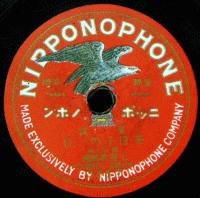 |
|||||||||||||||||
Late Taisho era The word "童謡 Douyou = Nursery rhymes / Children's song", which has been used in the meaning of “わらべ歌 (Warabe-uta.This song has been handed down and sung since ancient times. Traditional Nursery Rhymes)” while retaining this concept, has a new meaning of “artistic fragrant song created for children”. It was 鈴木三重吉 Miekichi Suzuki who did it. https://en.wikipedia.org/wiki/Miekichi_Suzuki Suzuki was a novelist and children's literary artist from Hiroshima City, Father of Japanese Children's Cultural Movement. Suzuki launched the children's magazine "赤い鳥 (Akai tori - Red Bird)" in July 1918, and started to gently nurture it with a rich artistic taste, that is, without harming the beautiful fantasy and pure emotions of children. He wanted to give the children a song and a song, and named such a pure children's song a "童謡 Douyou". At the time, the poems written by children were also called "童謡 Douyou". For this reason, the word “童謡 Douyou” has been created and handed down by children collectively since the 1910s such three concepts were given. These concepts changed and mixed with the times. 1 わらべ歌 (Warabe-uta.This song has been handed down and sung since ancient times. Traditional Nursery Rhymes). 2 Artistic rich songs created by adults for children (創作童謡 Creative nursery rhymes, 文学童謡 literature nursery rhymes). 3 Children's poems written by children. |
|||||||||||||||||
| It can be said that "創作童謡 Sousaku Douyou" (creative nursery
rhymes) was born by the publication of the children's magazine "赤い鳥 Akai tori - Red Bird", but the children's rhymes that appeared in this magazine did not initially have melody. In the November issue of "かなりや Kanariya - Canary" was published as a 西條八十 Yaso Saijo's Nursery Rhyme poem. And the following May issue when May 1919 (Taisho 8) was published with a score by 成田為三 Tamezou Narita. This is the beginning of creative nursery rhymes. It is not a difficult esoteric song or a vulgar song, it is a song for children, a song that sang the heart of a child, a song that can be naturally hummed by a child instead of pressing it against a child Suzuki Miekichi's idea attracted many sympathizers, and the children's song popularization movement and the children's literature movement that included it became a major trend. |
|||||||||||||||||
| Following "赤い鳥 Akai tori - Red Bird", a number of children's
literature magazines were published, such as 斎藤佐次郎 Sajirou Saitou's "金の船 Kin No Fune - The Golden Ship", and in its heyday there were dozens of them. Among them, 北原白秋 Hakushu Kitahara and 山田耕筰 Kousaku Yamada of "赤い鳥 Akai tori - Red Bird" and 野口雨情 Ujou Noguchi and 本居長世 Nagayo Motoori of "金の船 Kin No Fune - The Golden Ship" (later renamed to "金の星 Kin No Hoshi - Golden Star") worked on many songs, building the golden age of nursery rhymes. 北原白秋 Hakushu Kitahara and 野口雨情 Ujou Noguchi were called the three great poets with 西條八十 Yaso Saijo, who moved from "赤い鳥 Akai tori - Red Bird" to "童話 Douwa -Fairy Tales" (Another Children's literature magazine). In the field of "純邦楽 Jun-Hougaku - Pure Japanese music", this was called "童曲 Doukyoku - Children's song". Japanese popular music is sometimes referred to as "邦楽 Hougaku - Japanese music". It is comparative terms with Western music which is popular music in Europe and America. It is also called "和楽 Wagaku - Japanese music" and "国楽 Kokugaku - Japanese music", and is sometimes called "純邦楽 Jun-Hougaku - Pure Japanese music" to distinguish it from Japanese popular music the Showa Kayoukyoku. For example, "さくらさくら Sakura Sakura" is an ancient 箏 koto song made for children at the end of the 幕末 Bakumatsu - Tokugawa period and has been around for a long time. In the Taisho era, 箏 koto was still more widely used in households than piano, so "童曲 Doukyoku - Children's song" by 葛原しげる Shigeru Kuzuhara (lyrics) and 宮城道雄 Michio Miyagi (composition) was used as a nursery rhyme with songs. It was earlier than the above-mentioned "かなりや Kanariya - Canary", which was said to be the first creative nursery rhyme. |
|||||||||||||||||
| In the Showa era, children's literature magazines gradually became sluggish,
and both the longest running "赤い鳥 Akai tori - Red Bird" and "金の星 Kin No Hoshi - Golden Star" were discontinued in 1929 (Showa 4). In addition, as the military power gradually increased, nursery rhymes were even dismissed by the Japanese military as weak-kneed or spineless. On the other hand, songs called 戦時童謡 (Senji Douyou - wartime nursery rhymes) such as "隣組 Tonari-gumi - Neighborhood" in 1940 (Showa 15), lyrics by 岡本一平 Ippei Okamoto, composed by 飯田信夫 Nobuo Iida) and "戦争ごっこ Sensou Gokko - War Play" these songs are released. The song, now known as "汽車ポッポ Kisha Poppo" (lyrics: 富原薫 Kaoru Fuhara, composed by 草川信 Shin Kusakawa), originally sang an expeditionary soldier entitled "兵隊さんの汽車 Heitai-san No Kisha - The Soldier's Train". |
|||||||||||||||||
| Japanese Education, During World War II The Imperial Rescript on Education (IRE) was extremely sanctified. In the 1930s, under the security legislation, the IRE was sanctified as the ideological basis of national education. Copies of the IRE was kept in a special place at most schools, along with "御真影" (Goshin-ei. photographs of the emperor and empress), such as 奉安殿, 奉安庫 (Hon-Anden, Hon-Anka). Students were also urged to recite the full text of the IRE. Especially during the intensification of the war, when the General Mobilization Act (Law No. 55 of 1938) was enacted and enforced in 1938, it was used to justify the system. As a result, it was used as a militaristic scripture in a way that deviated from the original meaning of the IRE. After World War II In 1945 (Showa 20), when the World War II was defeated and the occupation of the GHQ was reached, in 1946 (Showa 21), "Handling of the IRE and Imperial Books" (October 8, 1946) The Cultural Affairs Bureau issued a notification entitled "Notice of Education," which stopped reading the Imperial Rescript of Education as a fundamental norm of education, revised the rules of the National School Ordinance, and read the Imperial Rescript of Education at the ceremony of four major clauses at the educational site. It was abolished (Ministry of Education Ordinance No. 31, October 9, 1946). A book published in the United States in 1945 by Robert O. Ballou, Shinto: The Unconquered Enemy, describes the edict of education as what may be called the "Bible" of State Shinto. After World War II, the Allied Chief of Command, Commander-General (GHQ), was particularly concerned about the sanctification of the IRE, and the Ministry of Education read in 1946. Notified of not performing sacred treatment. In October 1946, the reading and descriptive treatment of the IRE was banned. The following day, in 1947, the Basic Law on Education (formerly the Basic Law for Education) was promulgated and enforced, and was set as the basis for education. Initially, the Government of Japan and the Diet attempted to position the Imperial Rescript on Education as "the basis of the Fundamental Law of Education," but this policy was not acknowledged by the Occupation Army. On June 19, 1948, a resolution on the elimination of imperial edicts was passed by the lower house, and a resolution on revocation confirmation of edicts was rejected by the House of Councilors. The revocation was confirmed, and the transcript was collected and disposed of. After the end of World War II in Asia following the surrender of Japan, the American occupation authorities forbade the formal reading of the IRE in schools, and the National Diet officially abolished it on 19 June 1948. The Council for Education held on November 16, 1950, Prime Minister 吉田茂 (Shigeru Yoshida) and others discussed the need for a moral code to replace the IRE as a standard of education, but many commented that it was not necessary. Accounted for. At the time of the Imperial Japanese Empire, there were no basic rules regarding the obligation of the citizens to provide their children with ordinary education (compulsory education), and the right of children to be educated (which must also be appropriate to their individual circumstances). It was enacted only after the Constitution of Japan was established after the war. |
|||||||||||||||||
| Before and after 1954, the expression of Japanese nursery rhymes on records,
especially on shellac picture discs, was different. Before the war, the Japanese government did military education to children through 絵本 Ehon records (Ehon = Picture books). Because Japan was imperial at the time. 日本繪本レコード株式會社 Japanese record company, translated as Nihon Ehon Record Co., Ltd. These releases are aimed at raising the public's will to promote the military. The country where my parents were born and the country where I was born are different. My parents were born in the Empire of Japan. But I was born in Japan. The post-war identity of the Japanese people was in conflict. Ehon records sample |
|||||||||||||||||
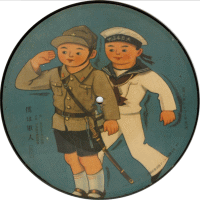 |
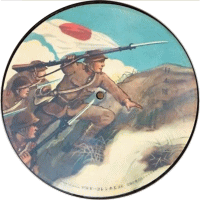 |
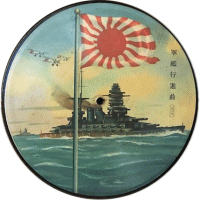 |
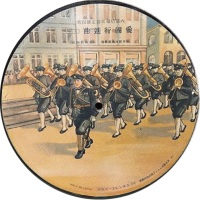 |
||||||||||||||
Toyo Kasei company of Yokohama acquired a production patent in 1953. (Only Toyo Kasei still produces vinyl records in Asia.) And Kanariya records (Kyoto) released gramophone picture disc as commercial production for the first time in Japan. Japan Victor records and Teichiku records competed following it. Their picture record expresses the unique yearning for the old days feeling that Japanese nostalgic design has. We can confirm that Japan switched over from militarism to democracy from these pure and innocent designs. Kanariya records sample |
|||||||||||||||||
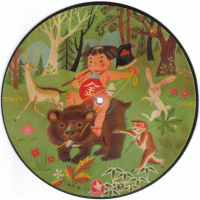 |
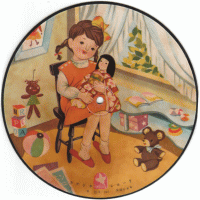 |
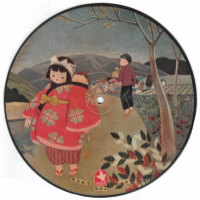 |
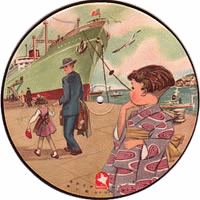 |
||||||||||||||
| One on the right Akai Kutsu (Red Shoes) https://en.wikipedia.org/wiki/Akai_Kutsu 赤い靴 / Akai Kutsu (Red Shoes) 赤い靴はいてた女の子 異人さんにつれられて行っちゃった A young girl with red shoes was taken away by a foreigner. 横浜の埠頭から汽船に乗って 異人さんにつれられて行っちゃった She rode on a ship from Yokohama pier taken away by a foreigner 今では青い目になっちゃって 異人さんのお国にいるんだろう I imagine right now she has become blue-eyed living in that foreigner’s land. 赤い靴見るたび考える 異人さんに逢うたび考える Every time I see red shoes, I think of her And every time I meet a foreigner, I think of her. This famous nursery rhyme was remembered and sung by any post-war Japanese like us as a child. But with these dark and scary lyrics, Japanese children thought foreigners were kidnapper.LOL |
|||||||||||||||||
| After World War II After the Second World War, there was also a baby boom in Japan, and people became interested again in children's songs. According to サトウハチロー Hachiro Sato (Japanese poet, nursery rhyme writer) in 1954, "In the second half of a certain company, the release number of nursery rhymes is greater than the release number of popular songs in the second half of the year." In Japan there was a baby boom from 1947 to 1949. The number of births in the last three years has exceeded 2.5 million, bringing the total number to around 8 million. 2,949,638 births in 1949 was the highest ever in postwar statistics, and this number is about 2.8 times that of 946,060 in 2017. Generations born during this period are called baby boomers. "ぞうさん Zou-san - Elephant" in 1948 (Showa 23), lyrics: まどみちお Michio Mado, composition: 團伊玖磨 Ikuma Dan and "犬のおまわりさん Inu No Omawari-san - Dog's policeman" in 1960 (Showa 35), lyrics: 佐藤義美 Yoshimi Satou, composition: 大中恩 Megumi Ohnaka, And many other songs still sung in the 2000s were played on radio and television. |
|||||||||||||||||
| On November 27, 1958, the Japanese Crown Prince Akihito and Michiko married.
This big news has made a boom in Japan. This has made television popular. Michiko married Crown Prince Akihito and became the Crown Princess of Japan in 1959. She was the first commoner and the first member of a religious minority (Her family is Roman Catholic to marry into the Japanese Imperial Family). Around this time, interest in marriage, babies and children in Japan has grown very high. With the spread of television, Japanese television stations have broadcasted many children's programs. |
|||||||||||||||||
| There is a national program that started on April 3, 1961. みんなのうた Minna no Uta - Everyone's Songs https://en.wikipedia.org/wiki/Minna_no_Uta This television station NHK is a national broadcasting station like BBC in UK. So the songs used in this show are strictly screened for safe content. Since this program is used in elementary school classes and the songs used in this program are also used in music classes, they are easily recognized as 童謡 nursery rhymes. There are many celebrities who have been involved in 童謡 nursery rhymes, such as "おもちゃのチャチャチャ Toy no Chacha-cha" in 1963 (Showa 38), lyrics: 野坂昭如 Akiyuki Nosaka, composition: 越部信義 Nobuyoshi Koshibe). Many 童謡 nursery rhymes have also been created from NHK's "Minna no Uta" and "With Mother". At the beginning of the broadcast, it was intended for upper grades and junior high school students. In the past, many songs sang the psychology of teenage boys and girls in addition to songs in a 童謡 nursery rhyme style. In the 1970s, children were well known and, along with Fuji TV's "ひらけ!ポンキッキ Hirake! Ponkikki" Also, unlike other TV songs, it was also sung at school events. Features of broadcast songs, In the early days, the main songs were songs with Japanese lyrics added to foreign songs, famous songs buried in Japanese favorite songs, and original songs. Classical singers sang popular, and songs that were sung in children's chorus for adults were also introduced. Since around 1970, it has been mainly original songs written for "Minna no Uta". In the early days of the song, "for children" and "healthy", the lyrics reminiscent of love were sometimes changed. In recent years, The program is generally used as filler between programs. While many of the episodes are aimed at children, a large percentage are not, so the program enjoys a wide audience. The program is used to introduce new songs from popular and new singers, as well as to highlight the talents of various animators and directors. A list of upcoming and currently airing episodes is listed monthly in magazines such as Animage and Newtype. The program producers are conscious of morning broadcast times and are changing the trend of broadcast songs for mothers, children, young people, mothers and children. |
|||||||||||||||||
| With the spread of television, Japanese TV stations have broadcasted many children's programs. Japanese children's television series "おかあさんといっしょ Okaasan to Issho - With Mother" 1959 “ロンパールーム Romper Room” 1963, "ママとあそぼう!ピンポンパン Play with Mom! Ping Pong Pan" 1966, "ひらけ!ポンキッキ Hirake! Ponkikki" 1973 "カリキュラマシーン Calicula Machine" 1974 After that, occasionally made big hits like "ピンポンパン体操 Ping-Pong Pan Exercise" in 1971 (Showa 46), lyrics: 阿久悠 Yu Aku, composition: 小林亜星 Asei Kobayashi), "およげ!たいやきくん Oyoge! Taiyaki-kun - Swim! Taiyaki" in 1975 (Showa 50), lyrics: 高田ひろお Hiroo Takada, composition : 佐瀬寿一 Juichi Sase) "山口さんちのツトム君 Yamaguchi-san's Tsutomu-kun" in 1976 (Showa 51), lyrics and composition: みなみらんぼう Rambou Minami, "だんご3兄弟 Dango 3 Brothers" in 1999 (Heisei 11), lyrics: 佐藤雅彦 Masahiko Sato, composition : 内野真澄 Masumi Uchino), but generally sluggish. The Japan Record Awards had a Nursery Rhyme Award category from the 1st (1959) to the 15th (1973). "ちいさい秋みつけた" "おもちゃのチャチャチャ" "ムーミンのテーマ" "ピンポンパン体操" etc. were awarded. |
|||||||||||||||||
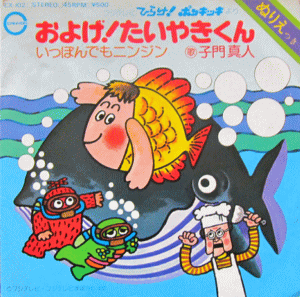 But the big hit of "およげ!たいやきくん Oyoge! Taiyaki-kun - Swim! Taiyaki" made controversy. https://en.wikipedia.org/wiki/Oyoge!_Taiyaki-kun Taiyaki (a fish‐shaped pancake filled with bean jam) This is a melancholy song that treats Taiyaki as a salaried worker and mocked Japanese society. He tired of the rat race, he quit his job and moved to the sea. He adventures knowing real freedom at sea. However, he is caught and eaten by anglers. The lyrics of this song were ironic of the Japanese world at the time, so it became a timely topic. "Oyoge! Taiyaki-kun" (およげ!たいやきくん, lit. "Swim! Taiyaki") is a song by Japanese singer 子門真人 Masato Shimon, released by Canyon Records (now Pony Canyon) on December 25, 1975. The B-side "いっぽんでもニンジン Ippon Demo Ninjin" was sung by Japanese folk singer なぎらけんいち Kenichi Nagira. However, the label claimed that the song was a 童謡 children's song because the song was used in Japanese child television program Hirake Ponkikki. Because if this song is a 童謡 children's song, it will be tax free and the label can make a lot of money. On the Oricon weekly chart, it became the first single to debut at number one in the Oricon history on January 5, 1976, and stayed there for 11 consecutive weeks. It surpassed the sales of "女の道 Onna no Michi" and eventually sold over 4.53 million copies, becoming the best-selling song in Japan. This record was certified by Guinness World Records. Despite the success, the company paid Shimon only 50,000 yen (approximately 170 dollars given the exchange rate at the time) as a guarantee. Five days before the record was released, the Shinagawa Tax Office was teaching 童謡 children's songs categorize. At that time, the label had not filed an excise tax (repealed on April 1, 1989) on this record. However, adults also bought records of this song that became a social phenomenon. Due to the fact, this record caused complaints about whether the record was treated as a taxable song or a tax-exempt 童謡 children's songs under the Excise Tax Law. However, the excise tax was exempted on February 23, 1976, when the National Tax Service officially determined that the song was a 童謡 children's song. For this reason, sales (wholesale price) excluding copyright royalties are mostly profit of three companies: Canyon Records (released by), Fuji Pony (master production), and Fuji Music Publishing (currently Fuji Pacific Music) (music publisher). As a result, major record companies maliciously printed 子供向 credits on the labels of their anime and hero program records for tax exemption, but all but a few were rejected by the Japan Tax Office. |
|||||||||||||||||
| Records were generally taxable under excise tax law, It was tax exempt if it was judged as a 童謡 nursery rhyme in consideration of education. For this reason, 皆川おさむ Osamu Minagawa's "黒ネコのタンゴ Volevo Ungattonero - Black Cat Tango'', 子門真人 Masato Shimon's "およげ!たいやきくん Oyoge! Taiyaki-kun'', わらべ Warabe's "めだかの兄妹 Medaka Brothers" there was a debate as to whether records were taxable. "黒ネコのタンゴ Volevo Ungattonero - Black Cat Tango'' was judged as a 童謡 nursery rhyme by the Tokyo National Taxation Bureau, but other National Taxation Bureau jurisdictions The inconsistency that the song was regarded as a 歌謡曲 pop song and taxed occurred. "およげ!たいやきくん Oyoge! Taiyaki-kun'' was determined to be a 童謡 nursery rhyme and was exempt from tax. For the "めだかの兄妹 Medaka Brothers", the B-side song "春風の郵便屋さん Spring breeze postman" was judged as a 歌謡曲 (popular song), and the B-side song was judged to be taxable due to its longer playing time. Four Life Records, which released this single "めだかの兄妹 Medaka Brothers", dissatisfied with this and negotiated with the Tokyo National Taxation Bureau. Eventually, Four Life Records accepted it and they paid excise tax as an extra payment. "Tokyo National Revenue Service, excise tax on anime songs. 40 million added to major record company" 日本経済新聞 Nihon Keizai Shimbun (The Nikkei), June 13, 1986, morning edition, page30. "Due to the tax law, exemption from excise tax was made when the record genre was a 童謡 nursery rhyme, and some record companies treated anime songs as 童謡 nursery rhymes." https://ja.wikipedia.org/wiki/%E7%AB%A5%E8%AC%A1 |
|||||||||||||||||
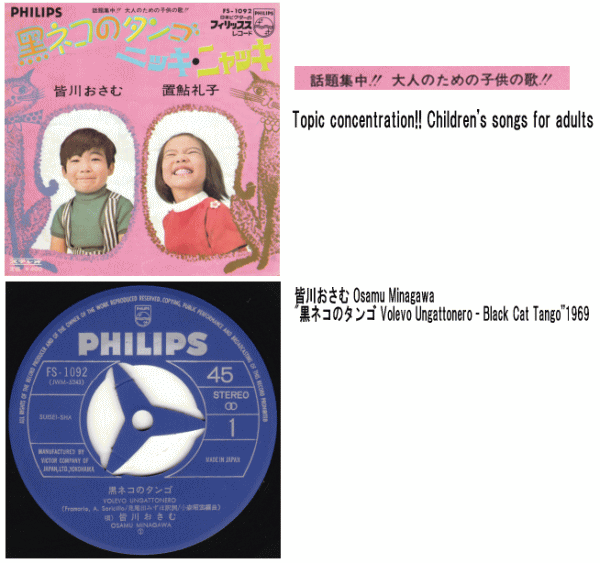 |
|||||||||||||||||
According to Japanese tax laws, many Japanese major record companies treated their anime songs and hero songs as 童謡 children's song / nursery rhymes, because exemption from excise tax (repealed on April 1, 1989) was made when the genre of records was 童謡 children's song / nursery rhymes. This is the most important point. 童謡 children's song / nursery rhymes were duty-free at Vinyl record era in Japan. However, in Japan, CD era's nursery rhymes have been taxed since April 1, 1989. A more extensive example of the word 童謡 children's song / nursery rhymes is "日本童謡集 Japanese Nursery Rhymes" (edited by 寺山修司 Shuji Terayama). The book cited the selection criteria as "whether it was a song with children", and military songs, TV theme songs, commercial songs, sex songs that banned broadcast, and Yakuza movie theme songs were also treated as "童謡 children's song". |
|||||||||||||||||
| 少年少女合唱団 Boys and girls choir / 童謡歌手 nursery rhymes singer After the war, many boys and girls choirs were formed and contributed to the spread of 童謡 nursery rhymes. 音羽ゆりかご会 Otowa Yurikago-Kai (日蓄兒童合唱團 Nicchiku Children Choir / コロムビアゆりかご会 Columbia Yurikago-Kai / 東京放送児童合唱団 Tokyo Broadcasting Children's Choir) A Japanese children's choir founded in 1933. It is the only choir in Japan that has been active since prewar days. A nursery rhyme writer 海沼實 Minoru Kainuma founded 音羽ゆりかご会 Otowa Yurikago-Kai at 護国寺 Gokokuji Temple in Otowa, Bunkyo-ku, Tokyo. They are in charge of the theme song "とんがり帽子 Tongari Hat" for the radio drama "鐘の鳴る丘 Kane no Naruoka" broadcasted for three and a half years. They played a central role in the post-war 童謡 nursery rhymes boom, and produced 童謡 nursery rhymes singers of three sisters, 川田三姉妹(正子、孝子、美智子) Kawada (Masako, Takako, Michiko). There was 増永丈夫 Takeo Masunaga. This boy is the later national singer 藤山一郎 Ichiro Fujiyama. These are children's choirs in Tokyo that were founded during and after the war. They are Tokyo-based choirs and sang themes and commercial songs for TV programs, and sometimes appeared on TV choir programs. ひばり児童合唱団 上高田少年合唱団 サカモト児童合唱団 西六郷少年少女合唱団 荒川少年少女合唱 みすず児童合唱団 杉並児童合唱団 滝野川少年少女合唱団 東京少年少女合唱隊 東京少年合唱隊 NHK東京児童合唱団 童謡 Nursery rhymes have also spawned many 童謡歌手 nursery rhyme singer. 本居みどり Midori Motoori, the eldest daughter of 本居長世 Nagayo Motoori is Japan's first 童謡歌手 nursery rhyme singer. three sisters, みどり Midori, 貴美子Kimiko and 若葉 Wakaba were performed on the records and radio broadcasts. 童謡 Nursery rhymes on the TV program have been handed down to 安西愛子 (Aiko Anzai, うたのおばさん) and 小鳩くるみ (Kurumi Kobato おかあさんといっしょ) 茂森あゆみ (Ayumi Shigemori おかあさんといっしょ) |
|||||||||||||||||
| Japan and the West have different cultures and customs for Children's. At that time, Japanese animation songs on the record did not adapt to European standards for Children's. Children's must be music made primarily for children listening. Nursery Rhymes, Fairy Tale, Childrens Story Record, Sing-Along, Educational music https://en.wikipedia.org/wiki/Children%27s_music Children's music or kids' music is music composed and performed for children. In European-influenced contexts this means music, usually songs, written specifically for a juvenile audience. The composers are usually adults. Children's music has historically held both entertainment and educational functions. Children's music is often designed to provide an entertaining means of teaching children about their culture, other cultures, good behavior, facts and skills. Many are folk songs, but there is a whole genre of educational music that has become increasingly popular. The Children's is a genre used for Educational music, Because in Japan, nursery rhyme records become tax-exempt products. Nursery Rhymes, Fairy Tale, Childrens Story Record, Sing-Along, |
|||||||||||||||||
| There is no "Children's" category in the Japanese market. In Japan, Anime and Hero records are excluded from 童謡 Nursery rhymes / Children's for tax purposes. Japanese major record companies have abused "子供向" (For Children) credits to avoid tax. |
|||||||||||||||||
In Japan, Anime record / hero record just under the movie soundtrack. You can choose Soundtrack, Story, Dialogue category for Japanese Anime album Drama edition. You can choose Theme for opening theme song / ending theme song, Japanese OVA and Novel's image album. We monitor statements illegality on Japanese products that are likely to be misuse of explanation under Japanese law. Since this is a Japanese product, we have corrected it to the Japanese standard. This is a matter that Japanese tax office have pointed out. Because in the case of "Children's", it is a tax-free product in Japan. If the wrong recognition spreads to the world, Japanese record companies try to evade tax payment with using this kind of wrong customs. “子供向” are not "Children's". 子供 (謙譲語 = Honorifics) 20歳未満の者 / Children under 20 years old. At elementary school in Japan, We could only watch NHK educational programs in class. We could watch "ひょっこりひょうたん島" But We could not watch "愛の若草物語" and such ハウス世界名作劇場 on Fuji TV. This series 世界名作劇場 releases relatively safe programs as the sponsor is foodservice companies and the theme is that can be enjoyed by family members. But even that is not an educational program in Japan. This is the difference between "Children's" and "子供向". "子供向" does not include educational content. But “Children's” must include educational content. Even Middle Age users in Japan are also misunderstanding "子供向" credit. Perhaps it is because they do not know the Japanese record industry of the 1970s and 1980s when "子供向" credit spread. 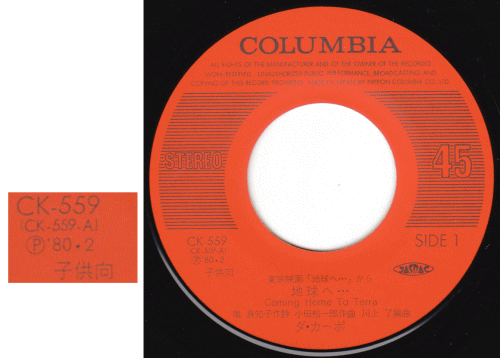 |
|||||||||||||||||
"子供向" credit printed on the label, single front cover and obi top of album what is not for music genre. There is no music genre called "子供向". Because they also print "流行歌" (Populer Music) as well but there is no music genre called "流行歌" (Populer Music). The record company does not categorize the music of the product. These credits are due to the administrative division of wholesalers and retailers. At that time the Japanese products especially vinyl record era, Japanese companies did not categorize products or cater to Western standards. Naturally the Japanese animation soundtrack at that time does not fall under the Western standard specified by Wikipedia in recent days. Do not compel the current Western standards to Japanese products at the time. Even now Japanese Yahoo Auction does not have the category "Children's", Japanese record companies, wholesalers and retailers do not have the concept of "Children's" when this record is released. As you know, Japanese convenience stores are selling harmful adult books. However this is a part of Japanese culture. Anime that is aired in commercial broadcasting has a directing that gives priority to getting audience rating, and there is no educational program there. Because they could make harmful direction for audience rating. Of course, "子供向" credit does not guarantee safe content for children. |
|||||||||||||||||
| I understand that you do not know the history of Japan's economy and the originality of the Japanese record industry at that time. In addition, you do not know the cultural background of Japanese education theory. Especially the relationship between Japanese education and subculture after the war. This has a great influence on Japanese animation products and programs. Japan has a different culture and history than the Western market. the Japanese market has big wholesale companies. 星光堂 (Seikodo), WINT (日本レコード販売網 JARECS, Lilac trading) I was a Seikodo’s member. The retailers must go through either wholesale company. If the retailer does not pass the wholesale company, the retail store can not purchase the record / CD released by the major company. Of course, they can not sell discounted new items like the American market. However, retailers can return records / CDs to major companies via wholesale companies. The retailers will report their customers' reactions to the record companies via wholesalers. The wholesale company reports the return rate to the record company. The record company then decides whether to additional pressing the product. And record company analyzing sales by region tell sales strategies to wholesalers. "子供向" credit on the record is consideration for the sales section. Due to the expansion of the record store area, the large store had several sales sections. To find out details of sales from retail stores, retailers sent credit-specific reports to Japanese wholesalers for each categories. The record company decides the product production period by judging the resale ratio by their report and back-order. https://ja.wikipedia.org/wiki/%E5%86%8D%E8%B2% And products which over the period would be out of print. As a result, retail stores can only be ordered from the inventory owned by wholesalers. "子供向" credit is due to the division of the sales section as the market expands. In fact, when I and my friends belonged to a Japanese major record company, credits differed depending on the production department and the request of the production office. We inserted survey card that classified the sales section to reduce the return rate. Do not confuse it as it does not mean “Children's”. To be exact, "童謡、教育" credits fall under the Western standard "Children's". In Japan, records that have been "童謡、教育" credits are treated as tax-free products. There was also record companies that treated as "童謡" for anime songs. However, in 1986 (Showa 61), the excise tax was the Tokyo National Tax Bureau judged "not to be classified as a "童謡", but to be taxable" for the records of the animation song that Pony Records and Canyon Records treated as a "童謡". It was levied tax 40 million yen. If you are a Japanese who is interested in anime and nursery rhymes, you will remember this impressive affair. Judgment that "子供向" credit does not fall under "Children's" except for some like "まんが日本昔ばなし" etc. 子供 - 20歳未満の者 / Children under 20 years old. "ハウス世界名作劇場" was animation series with relatively safe content, and it was Pony Records and Canyon Records released their soundtracks and theme songs. They put those records into a "童謡" (Nursery rhyme) and tried to escape tax. But that was illegal. These records were not "童謡" (Nursery rhyme). It was a decision that the records of commercial animation programs were not "童謡" (Nursery rhyme). This is what was decided in the Japanese trial. In Japan, there was a provision to pay taxes at a press factory, there is also record companies that treats anime songs as "童謡" and abuses them, because the tax law exempts the excise tax from making the credits of records a "童謡". https://ja.wikipedia.org/wiki/%E7%89%A9%E5%93%81%E7%A8%8E |
|||||||||||||||||
| Ostensibly, Japanese record companies printed "子供向" credit
as a sales segment with wholesale and retailers in mind. They tried to emphasize "子供向" credits, especially in the 70's and 80's. And They wanted to make that "子供向" credit correspond to "童謡、教育". However, Japanese tax office pointed out that Japanese record companies abused credit for tax escape. Anime song and hero records are not "童謡、教育" ("Children's"). Game music also. In Japan, if the "童謡、教育" credit is abused it is strictly punishable, because "童謡、教育" is exempt from tax. Therefore, if you misuse the "Children's" tag by "子供向" credit, you may be subject to punishment from the Japanese tax office. This is a Japanese product, we have corrected it to the Japanese standard. National Tax Agency JAPAN is calling for your cooperation. Thank you for your cooperation. This sources: Recording Industry Association of Japan (RIAJ) and Japan Record Commerce Association, The Association of Children’s Song Writers in Japan. |
|||||||||||||||||
| 【戻る】 | |||
| Copyright (C) 2004 coolhand-records.com. All Rights Reserved. |